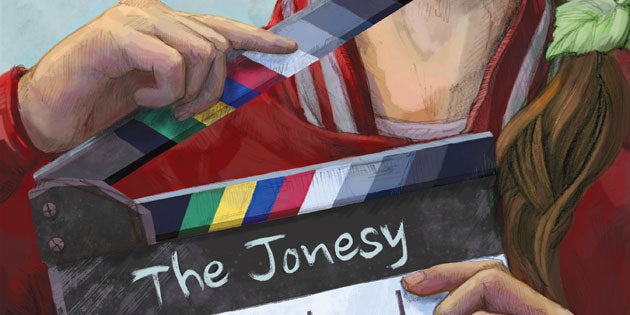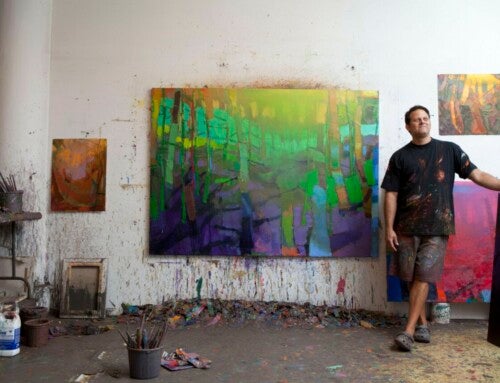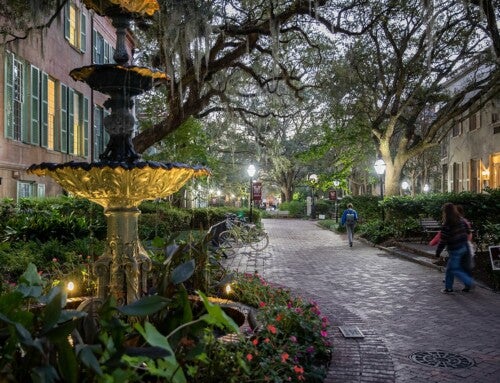
Sarah Jones ’09 had a promising career in the film industry before her life was cut short in February 2014.
It was just the beginning. That time when a sweet buzz of anticipation, hope, excitement still clings. Things were wide open, possibilities in every direction. And she was ready to roll, ready for action. Anybody could see it: Sarah Jones ’09 was just getting started.
Jones’ adventure in the film industry began in 2007, when she interned with Lifetime’s Army Wives. She immediately became known on set for her smile and her laugh, and for her dedicated work ethic and her bright, eager attitude. She had a kind of purposeful enthusiasm – the kind of energy that translates into appreciation for the little things and a determination to do her best work. And her energy was contagious. She made veterans of the industry remember why they loved this job, and she gave the newbies something to aspire to.
She was, by all accounts, a rising star.
“Sarah had an intuitiveness to her. She had a curiosity. She kept her head down and got the job done,” says Stephen Yetman ’83, a location manager who worked on Army Wives all seven seasons. He recalls being proud of Jones when she joined the camera crew after two years of interning: “It struck me that she was really brave – not just because she was a girl in the South in this industry, that’s hard enough. But the camera crew, that takes a lot of work and a lot of strength.”
Yes, Jones chose a physically tough, overwhelmingly male discipline within the industry. But it made sense: She’d always loved being behind the camera. Even as a child, she spent hours making movies of her brothers and sisters rolling down the stairs of her family home in West Columbia. Plus, she had drive. Sure, the gear she had to haul around was often twice her size, but she huffed and puffed and found a way to make it work. It’s what earned her the nickname, The Ant.
Just like an ant, Jones was always hustling, putting work first. She became a respected member of the International Cinematographers Guild (Local 600) and, when she moved to Atlanta in 2011, she was soon a treasured addition to the tight-knit Atlanta film community, as well – working with the CW’s The Vampire Diaries and other productions, including Fast & Furious 7.
With her surprising strength, her unstoppable can-do attitude and her zest for life, this tiny South Carolina girl – oversized tool belt hanging heavily around her waist – was making a name for herself. Sarah Jones had started something – something big.
Quiet on the Set
It was February 20, 2014, and Jones was starting something new. That’s a bonus in this industry: Your script is always changing – there’s always a new scene to explore, a new adventure to begin.

The 110-year-old metal train trestle over the Altmaha River in Wayne County, Ga., where a dream sequence was being shot for the Gregg Allman biopic, Midnight Rider.
It was her first day on the job, working on Midnight Rider: The Gregg Allman Story, a biopic starring William Hurt as the rock and blues singer-songwriter. She and the 21 other crew members met in a studio in Savannah before heading out to their location on the Altmaha River in Wayne County, Ga.
It was a windy day, and the crew was shooting a dream sequence on a 110-year-old metal train trestle. Before they’d set up the twin-size metal-framed bed and mattress in the middle of the tracks, two freight trains had barreled through. Now, they were told, it was safe to shoot on the tracks.
It was, some crew members worried, a little precarious up there. It didn’t calm any nerves when someone back on the shore yelled up at them, “If you see a train coming, you have 60 seconds to clear the tracks!”
Eyebrows raised. Seriously?
While the concerned crew members huddled together in prayer, however, Jones prepared the equipment for the shoot. She trusted that the director, Randall Miller, wouldn’t put them in danger. Why would he? That wouldn’t make any sense.
Some things, we all know, don’t make sense. So, let’s make this fast – that is how it happened.
When they spotted the train hurtling toward them at 58 mph, its horn blasting, there was panicked chaos. A scramble for safety. They couldn’t move the bed out of the way. There was no time.
“Just drop it!” people were screaming at Jones when she tried to grab the camera equipment. “Just run!”
There was nowhere to run.
Some, including Miller and Hurt, had escaped, but others were crammed onto the metal walkway, inches from the track – and Jones and the hair and makeup artist, Joyce Gilliard, were forced onto the gangplank. They were too close.
As the train tore across the trestle, it pulled Gilliard’s left arm with it and ripped through the metal bed, sending shrapnel flying and pulling Jones onto the tracks.
Gilliard opened her eyes. She looked at her arm and saw bone and blood. Then she looked for Jones. And, just like that, Jones was gone. Just like that.
This wasn’t how it was supposed to go. It was supposed to be an adventure, not a tragedy – a beginning, not an end.
It was, however, far from the end. When you have what is being considered the biggest safety-related scandal to rock Hollywood in over a decade, there’s no end in sight.
This, in fact, was just the beginning.
Roll Camera
They shouldn’t have been there to start with. Unbeknownst to the crew, the Midnight Rider filmmakers not only had been denied permission to film on the train trestle, but they’d hidden that information.
In an email to the Film Allman production company, CSX Transportation officials stated that the request to film on the railroad could not be approved for safety reasons. However, the film company did not comply.
“The email was confusing,” they told Occupational Safety & Health Administration investigators. Executive producer Jay Sedrish says he dismissed the denial because it was “a no, but not a forceful ‘No.’”
“They didn’t have permission to be there, which is just wrong,” says Yetman, Jones’ colleague from Army Wives. “Railroads aren’t the easiest to deal with anyway – and rightly so: They present a great liability to film on. But putting those people out there on the tracks is unconscionable. It’s unforgivable.”
OSHA agreed. With a penalty of $75,000, they issued Film Allman a “serious citation” for putting its crew at risk for falls from the trestle and a “willful citation” for putting the crew in danger of being struck by a train.
In addition, Miller, Sedrish, co-writer/producer Jody Savin and first assistant director Hillary Schwartz were all charged with involuntary manslaughter and criminal trespass. Miller, Sedrish and Schwartz pled guilty, but Savin’s charges were dropped as part of Miller’s plea agreement. Miller is currently spending two years in prison before serving an eight-year probation. Sedrish and Schwartz were fined and sentenced to 10 years of probation.
“These people are morally corrupt,” says Yetman. “They didn’t even think of the safety of their crew.”
According to OSHA reports, the filmmakers forwent critical safety protocols: There was no safety meeting, no medic on site, no safety information on the call sheet (in fact, there was no checklist for the day’s shoot whatsoever).
“Just the fact that the location crew wasn’t on location tells you they knew what they were doing was wrong,” says Yetman.
Indeed, investigations by the National Transportation Safety Board and the Federal Railroad Administration found that the film’s location manager refused to attend the shoot because he knew they didn’t have permission to be there.
Within days of the tragedy, the filmmakers requested permits to continue filming, thus prompting Hurt to pull out of the film and Gregg Allman himself to make this appeal: “Your desires as a filmmaker should not outweigh your obligations as a human being, I am asking you to do the right thing and to set aside your attempts to resume the production out of respect.”
And the film industry, for its part, showed its respect in its outpouring of support. To them, this tragedy means more than money or movies. It means an opportunity to be better. And, collectively, the film industry looks to Jones’ determined spirit to inspire that change: We are all Sarah Jones. And Sarah Jones is any one of us.
Action
Sarah Jones had started something. Something pretty amazing. Something that could make history. Redefine an industry. Save a life. Save quite a few lives.
When the news of the Midnight Rider tragedy got out, the reaction was fierce – people from all over the world, strangers and friends alike, expressed grief, anger and disgust with the senselessness of this death. Remember, the film community is a tight one, with crews often overlapping on different projects. For all crews everywhere, this hit home.
“She is any one of us,” Drew Duncan, an Atlanta-based creative consultant who did not know Jones, wrote in his blog, Drewprops. “The events that led to Sarah’s death could have happened to any man or woman working in the film industry, in any state, in any country anywhere around the world. What happened to Sarah happened to us all. … Sarah has reminded crews from around the country and around the world that beyond our regional rivalries we’re all interconnected and that these avoidable ‘accidents’ can happen anywhere in the world. In the end, I am Sarah, and you are Sarah. She is any one of us.”
By Sunday, February 23, a Facebook campaign encouraging everyone going to the Academy Awards to wear a black pin in honor of Jones had 2,600 likes; 60,000 people had signed an online petition for Jones to be included in the “In Memoriam” video segment of the show. Although she was not featured there, she was recognized by a photo and caption at the end of the segment.
In another online movement, Slates for Sarah, actors and film crews from around the world paid Jones respect by posting photographs of their clapboards with notes in her honor – a fitting tribute, as one of Jones’ duties was clapping the slate at the beginning of each take. Photos of messaged slates came pouring in from actors and crewmembers from Glee, The Mindy Project, Castle, Brooklyn Nine-Nine, Revenge, The Vampire Diaries, Parenthood and Parks and Recreation, just to name a few.
Several TV shows dedicated episodes to Jones, as well: The Walking Dead, Drop Dead Diva, The Vampire Diaries. And, all across the country, the first shoot of the day became known as “the Jonesy.”
“I’ve had a lot of people saying, ‘I haven’t seen something like this in 30 or 40 years in the film industry,’” Jones’ friend and coworker Eric Henson told CNN. “The solidarity of people coming together has really been incredible.”
All her life, Jones had been bringing people together, and now here she was, uniting people even after her death. It was a legacy all her own.
To continue that legacy and help sustain and focus the current environment of set safety awareness, Jones’ parents established the Sarah Jones Foundation, which, in addition to advocating for set safety, will award film scholarships and take on initiatives such as creating a safety report website for crews to report incidents, recommending a “time out” mechanism where crew members can pause production to address safety concerns and awarding a “safety stamp” for the credits of movies and shows that uphold the highest safety standards.
“While Sarah’s death seems to have made an impact on the industry, we want that to continue so that others can be safe while they work,” her father, Richard Jones, says, adding that We Are Sarah Jones, a new feature-length documentary about Sarah, her life, career, death and impact on the industry is in the works for a 2016 release.
Watch a public service announcement about Sarah Jones featuring Hollywood celebrities and film crew members.
At the Sundance Film Festival last January, the Jones family unveiled their three-minute public service announcement featuring people from all disciplines of the industry – including director David Lynch and actors Steven Yeun, Heather Locklear and Jack Black – imploring film crews to “stop and care” and make safety a priority.
“We want to go beyond talk and beyond concern,” says Richard Jones. “We want it to effect change, and we want to make the industry better.”
By most accounts, things are already better than they were at the time of Jones’ death. As of January 1, for example, OSHA requires much more thorough reports of on-set injuries, and all accidents that result in hospital visits must be reported. In addition, the International Alliance of Theatrical Stage Employees created an industrywide safety hotline, and the International Cinematographers Guild launched a safety app for reporting unsafe set conditions anonymously.
“The union and the film community really banded together after this to make some changes. The union has made certain we follow safety protocol,” says Yetman. “I think more people are sensitive to making sure all safety precautions are in place – that the i’s are dotted and the t’s are crossed.”
“I have noticed a difference on sets since the incident. I think everyone is more aware of safety issues and is asking questions and holding people accountable rather than trusting each department is doing its job,” agrees Jones’ friend Sarah Dano ’08, a set/costume designer who recently wrapped up work on Showtime’s Happyish (where, she notes, they had set safety meetings every morning). “In fact, I filmed on a train trestle this spring and we were all required to put on safety vests and a limited crew was allowed on the actual tracks. I felt every safety precaution had been taken and I don’t know that before last year it would have been the same.”
Jones certainly gave the film industry the wakeup call it needed, motivating people to stand up, get moving, come together, make things better. Be better. That’s what she always did. She brought a new energy to the table, to the set. She lit people up, got them excited, reminded them what really matters.
And, as far as we can tell, the impact of Sarah Jones’ life is just getting started.
This article first appeared as “The Jonesy” in the summer 2015 issue of The College of Charleston Magazine. Illustrations are by Jessica Bastidas.





